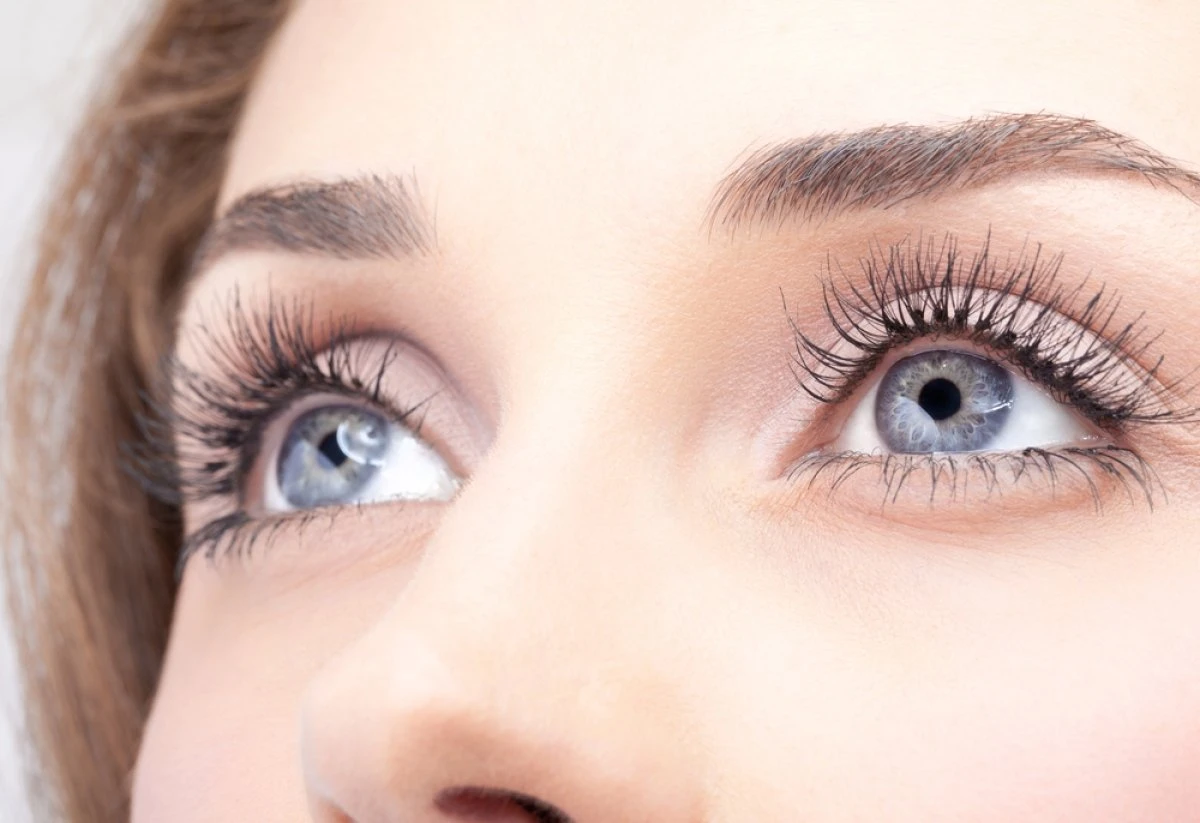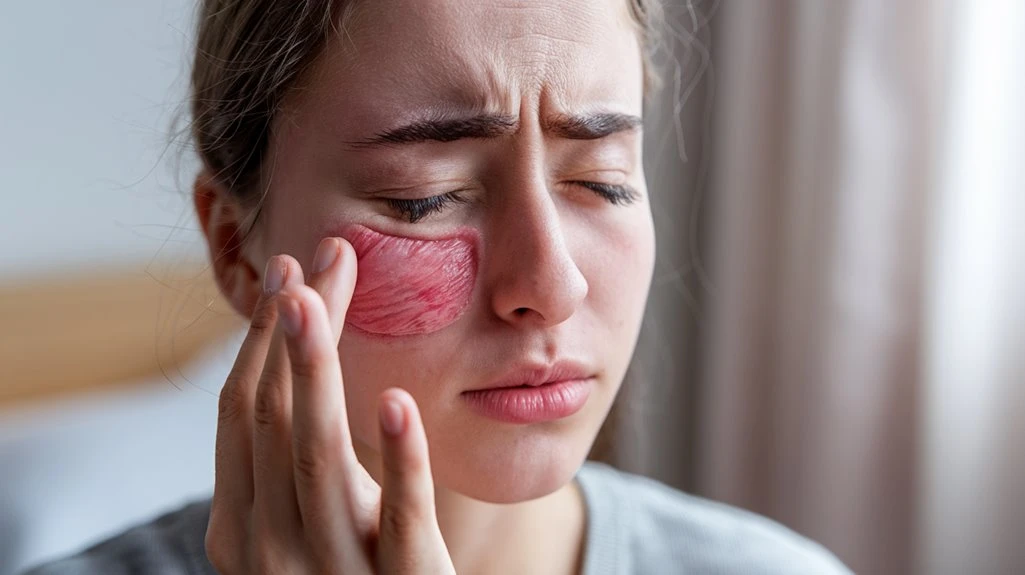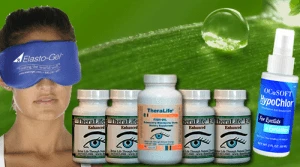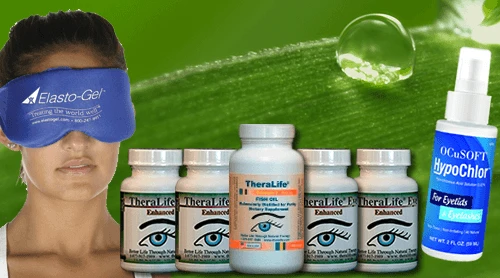Eyelid swelling and itching often result from allergens, irritants, or inflammation due to the thin, sensitive nature of the skin around the eyes. Theralife.com offers a range of products designed to address these symptoms by targeting the underlying causes, such as blepharitis and dry eyes, through natural and effective solutions. Their comprehensive approach includes addressing environmental triggers, enhancing eye hygiene, and improving overall eye health. This helps customers find relief and prevent recurrent issues. Recognizing early signs and symptoms is crucial, and persistent or severe cases may need urgent attention. For more information on prevention and treatment, Theralife.com provides insights and resources.
Best Eyelids Swell and Itch Treatment From TheraLife- When Drops Don’t Work.
Key Takeaways
- Environmental allergens like pollen, pet dander, and pollution can trigger immune reactions causing eyelid swelling and itchiness.
- Allergic or irritant contact with cosmetics, skincare products, or contact lenses often leads to localized eyelid inflammation.
- Chronic conditions such as blepharitis result in ongoing irritation, swelling, and itching due to inflammation of the eyelid margins.
- Poor eyelid hygiene allows debris and bacteria to accumulate, increasing the risk of swelling and itchiness from infections or inflammation.
- Sudden or severe symptoms, or those accompanied by pain or vision changes, may indicate infection or allergic reaction and require urgent medical attention.
Common Triggers of Eyelid Allergies- Eyelids Swell and Itch
Although eyelid allergies can arise from various sources, some triggers occur more frequently than others.
In clinical settings, environmental allergens like pollen exposure and pet dander are well-documented as primary culprits. When you’re exposed to airborne pollen, especially during peak seasons, your immune system may initiate an IgE-mediated hypersensitivity reaction. This can target sensitive periocular tissues, causing inflammation.
Likewise, proteins found in pet dander—microscopic shed skin fragments from cats, dogs, and other animals—can adhere to surfaces, including your pillowcases and hands, leading to inadvertent transfer to your eyelids.
Additionally, conditions like nodular episcleritis can also contribute to eyelid swelling and itchiness, as they involve inflammation of ocular tissues. Healthcare data consistently show that minimizing contact with these allergens reduces recurrence. Understanding the role of pollen exposure and pet dander helps you take proactive measures to avoid known triggers of allergic eyelid responses.
Recognizing Symptoms of Eyelids Swell and Itch
You’ll quickly notice eyelid reactions through signs like erythema, edema, or scaling. Pay attention to sensations such as pruritus, burning, or discomfort, as these often accompany visible changes. It’s important to assess the severity and monitor progression to determine if intervention is required. Additionally, understanding the common risk factors associated with eye conditions can help in identifying potential causes and preventing further complications.
Common Visible Signs
When eyelid reactions occur, you’ll often notice distinctive visible signs that aid in diagnosis and management. Anatomically, the eyelid is composed of delicate skin, muscle, connective tissue, and glands, making it particularly susceptible to changes.
You might observe periorbital edema—visible swelling localized to the upper or lower eyelid—often attributed to allergic responses, infections, or local irritation. Erythema, defined as redness of the skin, is another frequent clinical sign associated with inflammatory swelling causes.
Inspect for visible scaling, crusting, or even the presence of vesicles along the eyelid margin. Sometimes, the eyelashes may appear matted, or there may be evident discharge.
Additionally, conjunctivitis results in swelling, tearing, and redness, which are symptoms that can overlap with various eyelid reactions. Recognition of these physical findings, rooted in eyelid anatomy and consistent with multiple swelling causes, facilitates accurate assessment and informs clinical decision-making.
Sensations to Notice
How does eyelid irritation actually feel? You might first notice itchy sensations localized along the eyelid margins or diffuse across the entire lid. This pruritus can signal an underlying inflammatory process, often driven by exposure to allergens, irritants, or microbial agents.
Swelling causes a sensation of fullness, pressure, or puffiness, sometimes making it uncomfortable to blink or keep your eyes open for long. In many cases, you’ll sense the tissue becoming tense, even before visible edema emerges.
Burning or mild stinging often accompanies these symptoms, further suggesting involvement of skin barrier dysfunction or hypersensitivity reactions. Recognizing these early sensations—itchiness, swelling, burning—helps differentiate eyelid reactions from routine dryness or fatigue.
Prompt identification assists clinicians in determining the etiology and informs targeted management. Symptoms like redness and swelling may be linked to blepharitis, a chronic inflammation of the eyelid margins.
Severity and Progression
Although eyelid irritation may start with mild discomfort, symptoms can quickly intensify, signaling a need for medical assessment. Recognizing the progression of eyelid reactions is critical. Swelling causes vary—from localized infections to allergic responses—so you should monitor for escalating symptoms. Eyelid anatomy is complex, so inflammation may rapidly disrupt both function and appearance. Early intervention prevents complications like cellulitis or vision impairment. It is important to note that allergic reactions are among the most common triggers for eyelid swelling, often caused by environmental irritants like pollen and dust. Let’s review the evolution of symptoms:
| Symptom Timeline | Description | Clinical Significance |
|---|---|---|
| Initial itching | Mild pruritus in eyelid region | Early allergic/infectious sign |
| Redness begins | Erythema along lid margins | Indicates vascular response |
| Noticeable swelling | Periorbital edema develops | Possible barrier compromise |
| Pain intensity rises | Tenderness/pressure increases | Suggests severe inflammation |
| Visual disturbance | Blurred vision or field deficit | Requires urgent evaluation |
If symptoms escalate, seek medical care promptly.
Role of Allergens in Eyelids Swell and Itch
Because the thin skin of your eyelids is highly vascular and sensitive, exposure to allergens often triggers an immune response leading to swelling and pruritus.
When you’re exposed to allergen sources such as pollen, dust mites, pet dander, or certain cosmetics, your body identifies these substances as foreign invaders. Mast cells in your skin then release histamine, causing vasodilation, increased vascular permeability, and localized edema.
This cascade results in the characteristic itching and swelling you experience. In some cases, allergic conjunctivitis can occur alongside eyelid swelling, characterized by watery discharge, itchy/red eyes, light sensitivity, and possible eyelid swelling.
To help visualize common allergen exposures affecting your eyelids, consider:
- Environmental agents: pollen, mold spores, dust mites
- Contact allergens: eye makeup, topical medications, sunscreen
- Animal-derived particles: pet dander, hair, saliva
Recognizing allergen sources and understanding their mechanisms is essential for targeted prevention and management.
How Blepharitis Contributes to Discomfort- Eyelids Swell and Itch
When inflammation targets the eyelid margins, blepharitis often develops and leads to persistent discomfort.
You’ll notice that blepharitis causes redness, swelling, and irritation due to chronic eyelid inflammation. This condition typically arises from dysfunction of the meibomian glands, bacterial colonization (most often Staphylococcus species), or seborrheic dermatitis.
You might experience burning, pruritus, and a gritty sensation, frequently accompanied by crusting along the lashes. Chronic eyelid inflammation compromises the tear film’s stability, which can exacerbate both itching and swelling.
Repeated inflammation impairs the natural barrier of your eyelid margins, making them more susceptible to infection and persistent irritation.
Evidence shows that effective management requires targeted lid hygiene and, in some cases, topical or systemic therapy to reduce microbial load and inflammatory response in blepharitis. Good hygiene practices can significantly reduce the occurrence of blepharitis, with recommendations for regular eyelid washing to prevent irritation and maintain eyelid health.
Impact of Environmental Factors on Eyelids Swell and Itch
While chronic eyelid conditions like blepharitis are driven by internal inflammatory processes, external environmental factors frequently aggravate eyelid swelling and pruritus.
You’re particularly susceptible to environmental triggers, including variations in local climate and pollution exposure, both of which can compromise periocular skin integrity and intensify local irritation.
Fluctuations in humidity and temperature, along with airborne particulates, increase tear film evaporation and destabilize the ocular surface, contributing to eyelid edema and itching.
Evidence indicates individuals living in urban environments experience more frequent eyelid discomfort due to higher levels of air pollution and allergen loads.
Here are three primary environmental aggravators to take into account:
- Sudden climate changes trigger vasodilation in eyelid blood vessels.
- Exposure to industrial or vehicular pollution induces inflammatory skin responses.
- High allergen levels exacerbate immune-mediated periorbital inflammation.
For instance, dry eye syndrome can result from insufficient tear production, leading to a gritty sensation and potential vision loss.
Makeup and Cosmetic Product Irritation Resulting in Eyelids Swell and Itch
You may develop eyelid swelling and pruritus from exposure to allergenic ingredients commonly found in makeup, such as fragrances and preservatives. Cross-contamination can occur when you use unclean tools or share cosmetic products, increasing your risk of irritation and infection. Employing safe application practices, like regular brush cleaning and checking expiration dates, can help you minimize these adverse reactions. Warm compresses are often recommended for eye bump relief, as they help in managing conditions like chalazia by improving meibomian gland function.
Common Allergenic Ingredients
Many cosmetic products contain specific allergenic ingredients—such as fragrances, preservatives (like parabens and formaldehyde releasers), and certain dyes—that frequently trigger eyelid irritation and swelling.
These compounds can act as both contact allergens and irritants. Your eyelid skin is particularly thin and sensitive, making it more susceptible to adverse reactions.
If you’re prone to common household allergens or have heightened responses during seasonal allergy triggers, you’re at greater risk for developing dermatitis from cosmetic exposure. From a clinical perspective, repeated or prolonged use increases sensitization. One factor contributing to eyelid swelling and itching is the blockage of meibomian glands, which can lead to chalazion formation.
Consider these potential allergenic triggers in your products:
- Artificial fragrances: Found in perfumes, creams, and eye products, often associated with allergic contact dermatitis.
- Preservatives: Methylisothiazolinone and parabens are linked to eyelid inflammation.
- Color additives: Certain dyes, especially red pigments, can provoke hypersensitivity reactions.
Cross-Contamination Risks
Because cosmetic products often contact multiple surfaces and tools, cross-contamination remains a significant concern in eyelid irritation.
Cross contamination sources include makeup brushes, applicators, and shared cosmetics, which can harbor bacteria, fungi, or residual allergens. When you use contaminated products, microbial agents or sensitizing compounds may transfer to your eyelids, disrupting the delicate periocular skin barrier and triggering inflammatory responses.
Evidence shows that contaminated eye cosmetics are linked to higher rates of blepharitis, conjunctivitis, and allergic dermatitis.
Prevention strategies focus on limiting exposure to potential contaminants. You should replace cosmetics regularly, avoid sharing products, and disinfect applicators as recommended.
Identifying and managing common cross contamination sources is essential to minimize eyelid irritation and the risk of subsequent ocular or dermatologic complications.
Safe Application Practices
While cross-contamination heightens the risk of eyelid irritation, the technique and practices used during makeup application also play a critical role. If you want to minimize allergic reactions and mechanical irritation, it’s essential to focus on both safe product selection and gentle application.
Choose hypoallergenic and ophthalmologist-tested cosmetics, as evidence suggests these reduce the frequency of irritant and allergic contact dermatitis. Applying makeup with excessive force or using abrasive tools can disrupt the delicate periocular skin barrier, increasing susceptibility to inflammation.
Follow these clinical guidelines for ideal safety:
- Select fragrance-free, hypoallergenic products to decrease allergenic potential.
- Use clean, soft brushes or applicators, avoiding aggressive rubbing or tugging.
- Remove all eye makeup gently with non-irritating removers before bedtime.
These techniques considerably reduce eyelid swelling and pruritus.
Managing Contact Lens-Related Reactions To Eyelids Swell and Itch
Even slight irritation from contact lenses can trigger significant eyelid swelling and pruritus, particularly if an underlying allergic or hypersensitivity reaction is present.
If you’re experiencing these symptoms, assess your contact lens hygiene meticulously. Protein, lipid, and microbial deposits commonly accumulate on lenses, exacerbating inflammatory responses. Replace your lenses as recommended and guarantee proper disinfection to reduce antigen exposure.
Lens material sensitivity is another key factor—some individuals react to certain hydrogel or silicone hydrogel formulations, resulting in chronic eyelid inflammation. You may need to switch to daily disposable lenses or alternative materials.
Additionally, evaluate your lens cleaning solutions, as preservatives can induce toxic or allergic conjunctivitis. Consult your eye care provider if symptoms persist, as timely intervention is critical for preventing persistent ocular surface disease and visual dysfunction.
Importance of Proper Eyelid Hygiene
Although eyelid hygiene may seem straightforward, insufficient cleaning can perpetuate eyelid swelling and itching by allowing debris, bacteria, and allergens to accumulate along the lid margins.
You should adopt meticulous eyelid cleanliness tips as part of your daily hygiene routine to reduce microbial load, decrease inflammation, and prevent recurrence of symptoms like pruritus and edema.
Numerous studies link poor lid hygiene to chronic blepharitis and sebaceous gland dysfunction. Adhering to an evidence-based regimen is essential for maintaining ocular surface health.
To picture an effective eyelid hygiene approach, consider these key aspects:
- Use a sterile, moistened cotton swab to gently clean the lid margins.
- Apply a commercially formulated eyelid cleanser rather than soap, which can irritate delicate tissues.
- Rinse thoroughly and dry with a clean towel.
When to Seek Medical Attention for Eyelids Swell and Itch
How can you tell when eyelid swelling and itching require professional evaluation rather than home care?
If you experience rapid eyelid swelling, vision changes, severe pain, or difficulty breathing, seek immediate medical attention, as these may indicate serious allergic reactions or infections.
Persistent symptoms lasting longer than a few days, recurrent eyelid swelling, or associated systemic symptoms—such as fever—also warrant prompt assessment by an ophthalmologist or healthcare provider.
Don’t ignore eyelid swelling accompanied by discharge, crusting, or if over-the-counter treatments fail to relieve symptoms, as these could signal conditions like cellulitis or blepharitis.
If you’ve recently been exposed to allergens, monitor for systemic involvement, as eyelid swelling from allergic reactions may escalate.
Timely medical intervention reduces risk of complications and preserves ocular health.
Best Eyelids Swell and Itch Treatment From TheraLife- When Drops Don’t Work.
Frequently Asked Questions
Can Diet Affect the Likelihood of Eyelid Swelling and Itching?
Your diet can influence the likelihood of eyelid swelling and itching.
If you have nutrient deficiencies, such as a lack of vitamin B12 or omega-3 fatty acids, your skin’s barrier can weaken, making you more susceptible.
Consuming foods that serve as allergy triggers, like dairy, eggs, or nuts, may provoke an immunologic response, leading to periorbital edema and pruritus.
Identifying and modifying dietary risks can reduce recurrent symptoms.
Are Eyelid Swellings Contagious to Others?
You don’t usually need to worry about eyelid swellings being contagious unless they’re caused by specific infections, such as bacterial conjunctivitis or a stye.
In most cases, allergic reactions or poor eyelid hygiene don’t spread to others. Maintaining good eyelid hygiene can reduce your risk of infectious causes.
Clinicians recommend prompt evaluation of persistent swelling, as identifying the underlying cause guides proper management and limits potential transmission in communicable cases.
Do Certain Medical Conditions Make Eyelid Reactions More Likely?
Certain medical conditions can make eyelid reactions more likely for you.
If you have allergies and sensitivities, your immune system may overreact to pollen, dust, or cosmetic products, triggering swelling and itching.
Skin conditions, like atopic dermatitis or seborrheic dermatitis, can also compromise your eyelid’s skin barrier, increasing susceptibility to inflammation.
Evidence suggests these factors heighten your risk, so managing underlying conditions is essential to reduce recurrent eyelid symptoms.
Can Stress or Lack of Sleep Cause Eyelid Itching?
Attempt to run your life on caffeine, survive on four hours’ sleep, and juggle deadlines—your eyelids might issue protest signals.
Clinically, stress effects disrupt the skin barrier and immune function, while sleep deprivation impairs tissue repair. Both mechanisms heighten sensitivity, increasing pruritus (itching) and localized edema (swelling) of the eyelids.
How Quickly Do Swollen Eyelids Usually Resolve on Their Own?
Swollen eyelids typically resolve within a few days if you avoid allergy triggers and employ home remedies like cold compresses and gentle cleansing.
Clinical evidence shows that allergic or irritant reactions often subside within 48 to 72 hours, provided exposure to the inciting agent stops.
However, persistent swelling or additional symptoms—such as vision changes or severe pain—require prompt medical evaluation to rule out infectious or systemic etiologies.
Always monitor your symptoms closely.
Best Eyelids Swell and Itch Treatment From TheraLife- When Drops Don’t Work.
Conclusion
Eyelid swelling and itching often serve as a warning sign, indicating potential issues such as allergens, inflammation, or irritation from cosmetics and contact lenses. To address these concerns effectively, TheraLife offers a range of products designed to enhance ocular health and comfort. TheraLife’s natural treatments can help prevent complications like blepharitis or infections, offering relief from symptoms and promoting better eyelid hygiene.
TheraLife’s products are designed to treat conditions like dry eyes, blepharitis, chalazion, and uveitis naturally. By focusing on underlying inflammation and providing natural relief, these products help to maintain healthy eyelids and reduce the risk of recurrent issues. For instance, TheraLife’s Blepharitis Eye Makeup Guide provides tips on choosing the right cosmetics to prevent irritation, while their natural remedies for uveitis and chalazion offer alternatives to surgical interventions.
If you experience persistent redness, pain, or vision changes, it’s important to stay vigilant and consult a healthcare professional. TheraLife’s holistic approach, combined with medical advice, can significantly benefit your ocular health. Explore TheraLife’s comprehensive offerings to find solutions tailored to your specific needs, ensuring comfort and protection for your eyes.
References
- 1.Zug KA, Palay DA, Rock B. Dermatologic diagnosis and treatment of itchy red eyelids. Surv Ophthalmol. 1996;40(4):293–306. doi: 10.1016/S0039-6257(96)82004-2 [DOI] [PubMed] [Google Scholar]
- 2.Grey KR, Warshaw EM. Allergic contact dermatitis to ophthalmic medications: relevant allergens and alternative testing methods. Dermatitis. 2016;27(6):333–347. doi: 10.1097/DER.0000000000000224 [DOI] [PubMed] [Google Scholar]
- 3.Morris S, Barlow R, Selva D, Malhotra R. Allergic contact dermatitis: a case series and review for the ophthalmologist. Br J Ophthalmol. 2011;95(7):903–908. doi: 10.1136/bjo.2009.174607 [DOI] [PubMed] [Google Scholar]
- 4.Guin JD. Eyelid dermatitis: experience in 203 cases. J Am Acad Dermatol. 2002;47(5):755–765. doi: 10.1067/mjd.2002.122736 [DOI] [PubMed] [Google Scholar]
- 5.Katayama I, Koyano T, Nishioka K. Prevalence of eyelid dermatitis in primary Sjogren’s syndrome. Int J Dermatol. 1994;33(6):421–424. doi: 10.1111/j.1365-4362.1994.tb04044.x [DOI] [PubMed] [Google Scholar]
- 6.Papier A, Tuttle DJ, Mahar TJ. Differential diagnosis of the swollen red eyelid. Am Fam Physician. 2007;76(12):1815–1824. [PubMed] [Google Scholar]
- 7.Wolf R, Orion E, Tuzun Y. Periorbital (eyelid) dermatides. Clin Dermatol. 2014;32(1):131–140. doi: 10.1016/j.clindermatol.2013.05.035 [DOI] [PubMed] [Google Scholar]
- 8.Amin KA, Belsito DV. The aetiology of eyelid dermatitis: a 10-year retrospective analysis. Contact Dermatitis. 2006;55(5):280–285. doi: 10.1111/j.1600-0536.2006.00927.x [DOI] [PubMed] [Google Scholar]
- 9.Herro EM, Elsaie ML, Nijhawan RI, Jacob SE. Recommendations for a screening series for allergic contact eyelid dermatitis. Dermatitis. 2012;23(1):17–21. doi: 10.1097/DER.0b013e31823d191f [DOI] [PubMed] [Google Scholar]
- 10.Katoh N, Murakami M, Yasuno H. Eyelid dermatitis caused by delayed-type hypersensitivity to natural rubber latex. Contact Dermatitis. 1999;40(6):336–337. doi: 10.1111/j.1600-0536.1999.tb06095.x [DOI] [PubMed] [Google Scholar]
- 11.McDaniel LM, Couch SM. Allergic eyelid dermatitis as the sole manifestation of gold hypersensitivity. Ophthalmic Plast Reconstr Surg. 2017;33(4):e80–e82. doi: 10.1097/IOP.0000000000000783 [DOI] [PubMed] [Google Scholar]
- 12.Nethercott JR, Nield G, Holness DL. A review of 79 cases of eyelid dermatitis. J Am Acad Dermatol. 1989;21(2):223–230. doi: 10.1016/S0190-9622(89)70165-1 [DOI] [PubMed] [Google Scholar]
- 13.Assier H, Tetart F, Avenel-Audran M, et al. Is a specific eyelid patch test series useful? Results of a French prospective study. Contact Dermatitis. 2018;79(3):157–161. doi: 10.1111/cod.13040 [DOI] [PubMed] [Google Scholar]
- 14.Jacob SE, Stechschulte S. Eyelid dermatitis associated with balsam of Peru constituents: benzoic acid and benzyl alcohol. Contact Dermatitis. 2008;58(2):111–112. doi: 10.1111/j.1600-0536.2007.01178.x [DOI] [PubMed] [Google Scholar]
- 15.Valsecchi R, Imberti G, Martino D, Cainelli T. Eyelid dermatitis: an evaluation of 150 patients. Contact Dermatitis. 1992;27(3):143–147. doi: 10.1111/j.1600-0536.1992.tb05242.x [DOI] [PubMed] [Google Scholar]





